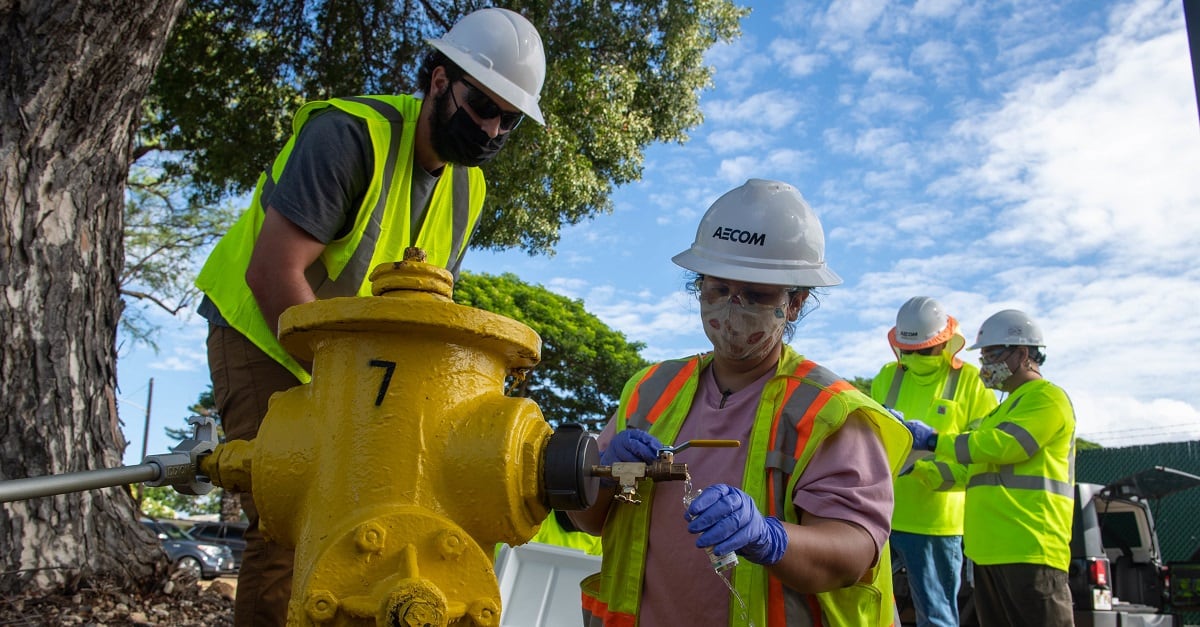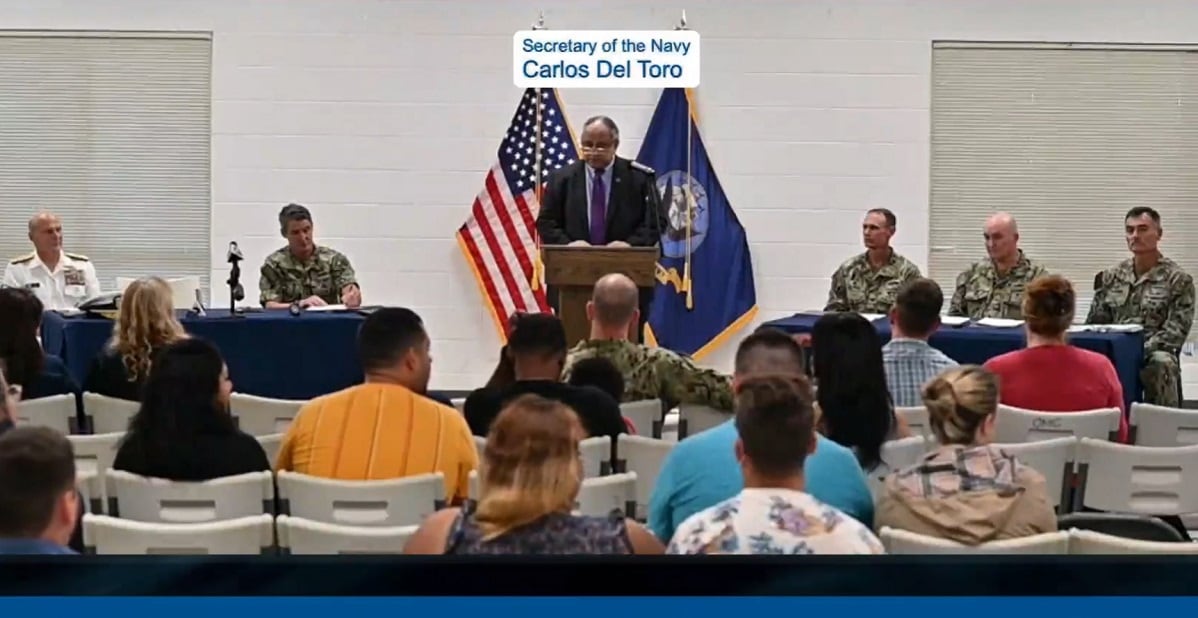Correction: This story was updated March 3, 2022, at 10 a.m. to include the Navy’s correction announcing the higher levels of lead were found indoors at a child development center, not outdoors, as previously stated..
As some military families in Hawaii continue to press for testing of water in more homes, officials this weekend released water test results showing higher-than-acceptable levels of petroleum and other contaminants in key areas — including lead in the water at an indoor utility sink at a child development center.
The Navy issued a correction late March 2 on a previous press release that reported the lead was found at an outdoor sink, stating that instead, it was found indoors in the laundry room of the Pier Side Child Development Center at the former Submarine Base Pearl Harbor. They previously didn’t identify the child development center.
Meanwhile, residents were questioning the visit of Secretary of the Navy Carlos Del Toro Feb. 25-28, described in a Navy press release, where Del Toro met with about a dozen families in a town hall. On the Joint Base Pearl Harbor-Hickam Facebook page, families wanted to know why there was no announcement ahead of time about a town hall. They also questioned how families were chosen for the limited town hall, and asked why the town hall wasn’t offered on Facebook Live like past events.
On Feb. 26, Navy officials reported finding higher levels of lead in a sample that came from a child development center at the former Submarine Base Pearl Harbor. The sample from an indoor utility sink tested positive for lead at a level of 49 parts per billion. The Environmental Protection Agency says a level of lead higher than 15 parts per billion indicates a potential threat to human health and may require future study.
The finding was one of eight announced by the Navy on Feb. 26 of contaminants found in the water that the Navy has worked for weeks to decontaminate. These are comprehensive tests for many contaminants, to include fuel, and have been part of the process the Navy has undertaken to flush the Navy water system, including the distribution system as well as the homes and facilities, following contamination.
About 9,000 households have been affected by the fuel-tainted water in the Navy water system. As of March 2, the water in four out of 19 neighborhoods has been cleared as safe for residents to use.
“Remediating this situation is a heavy lift,” said Del Toro, in a press release about his visit last weekend. “Many of our service members, civilians and families have been living in hotels since December or receiving bottled water for drinking, bathing, and cleaning in their homes. I want to personally thank them all for their patience through this unfortunate situation. Our teams are working around the clock to properly fulfill the needs of every family affected and we must continue to press forward until we have established a new normal that is better than before.”

Some residents questioned the limited town hall mentioned in a Navy press release after the event. “I’m confused, how were these families even chosen that he saw? Why didn’t he hold a publicized event like last time? This seems shady on all levels,” wrote one resident on Facebook.
Residents are calling for an in-person town hall with Navy officials. Daily water updates have been providing information and answering questions emailed from residents or posted on Facebook, but it’s not an interactive discussion.
Navy officials said there is no transcript or recording of the townhall.
“It was intended to be an intimate conversation between the Secretary and those families who attended,” said Navy spokesman Capt. Jereal Dorsey.
He added that those who attended volunteered through their commands, and their names were provided to Joint Base Pearl Harbor Hickam leaders, who helped coordinate the meeting.
“Due to space limitations not all who volunteered were able to attend,” Dorsey said.
A dozen families affected by the water crisis attended, including a mix of Navy, Air Force and civilian personnel who live in the various neighborhoods, he added. Topics included Temporary Lodging Allowance reimbursement, the testing and flushing process, health care concerns and a variety of other concerns.
When Del Toro visited Hawaii and held a town hall for families Dec. 5, hundreds of people attended in person and virtually. During the event, they grilled senior leaders about the causes and the response to the water crisis. At that Dec. 5 town hall, Del Toro apologized to the families and pledged to fix the problem.
RELATED

He made the visit last weekend to see the progress that has been made.
“This situation will remain unacceptable until all of the zones are within EPA and [Hawaii Department of Health] standards and all of our families are no longer impacted,” Del Toro said in the press release. “This has been a top priority for not only me, but also the Secretary and Deputy Secretary of Defense. We are committed to bringing together the full resources of the entire DOD and our interagency partners to address the issues facing the community. Our families in Oahu deserve transparency from their leadership at every step of this process.”
As the comprehensive test results from independent laboratories on the U.S. mainland are being received and evaluated by an interagency team, the tests are showing some elevated levels of contaminants in various buildings, including homes, after extensive flushing to remove the contaminants. Officials are posting test results, and notifying residents about issues of contaminants in specific buildings.
But some residents have been raising concerns about the Navy’s transparency, asking for the first tests on samples of their homes before the flushing decontamination process was started. Residents are concerned about the health effects of any contaminants being found.
Some are reporting persistent fuel smells and fuel sheens in their water after the flushing. Some are pressing for testing of all the homes before the water in neighborhoods is deemed safe, rather than the 10% currently being tested. Officials have responded that the Environmental Protection Agency generally recommends that 5% of homes be tested after such a flushing, but the decision was made in this case to test twice that number — 10%.
Officials have also been encouraging families who are still having problems with their water to contact their teams set up to return to the home and investigate.
Contaminants found
Lead was found in one child development center sample out of 21 samples collected at the former submarine base, officials said. The Interagency Drinking Water System Team has determined that the next steps are to sample, flush and re-sample. The Navy also replaced the fixture at the indoor utility sink before the sampling and flushing.
According to the Centers for Disease Control and Prevention, the most common sources of lead in drinking water are lead pipes, faucets and plumbing fixtures. Household plumbing fixtures, welding solder and pipe fittings made prior to 1986 may also contain lead. The American Academy of Pediatrics recommends all children be screened with a blood test at one and two years of age for lead exposure. Parents can also ask their pediatrician to screen for blood lead levels if they are concerned.
Another test result showed elevated levels of beryllium in water at the Pearl Harbor Elementary school, a Hawaii public school on the Navy water system. Their student population in grades K-6 includes many military children.
The test at the school showed a level of 5.7 parts per billion, and the safe level set by the Hawaii Department of Health is 4 parts per billion. Officials are sampling, flushing again and re-sampling for metals at the school.
Beryllium is a metal naturally found in mineral rocks, coal, soil and volcanic dust, and can be harmful if you breathe it, according to the Centers for Disease Control and Prevention’s Agency for Toxic Substances and Disease Registry. Long-term exposure to beryllium can increase the risk of developing lung cancer. But swallowing beryllium has not been reported to cause effects in humans because very little beryllium is absorbed from the stomach and intestines, according to the ATSDR.
Officials also found elevated levels of contaminants in tests at other locations:
- A Navy Exchange facility located near Bravo Piers tested positive for total petroleum hydrocarbons, at a level of 260 parts per billion. The combined limit for TPH set by the Hawaii Department of Health is 211 parts per billion. Officials are sampling, flushing and re-sampling the building, as well as sampling nearby facilities.
- One house in the Halsey Terrace neighborhood reflected a level of 460 parts per billion of a petroleum compound, compared to the acceptable level of 211 parts per billion. Officials are re-flushing and re-testing the house.
- A vacant house in the area of McGrew and Halawa neighborhoods showed a level of 42.4 parts per billion of an organic compound called bis(2-ethylhexyl)phthalate, also known as di(2-ethylhexyl)phthalate or DEHP. DEHP is frequently used in the production of polyvinyl chloride or PVC, and is not a known component of JP-5 fuel, officials said. Officials are re-flushing and re-testing the house.
- Two non-residential buildings in the neighborhoods of Catlin Park and Radford Terrace also showed elevated levels of DEHP — 23.8 parts per billion and 18.3 parts per billion. Re-flushing and re-testing has been ordered.
- A non-residential building in a ship forces work area at Pearl Harbor Naval Shipyard at a level of 26.4 parts per billion. More sampling, flushing and re-sampling is on order.
Karen has covered military families, quality of life and consumer issues for Military Times for more than 30 years, and is co-author of a chapter on media coverage of military families in the book "A Battle Plan for Supporting Military Families." She previously worked for newspapers in Guam, Norfolk, Jacksonville, Fla., and Athens, Ga.
